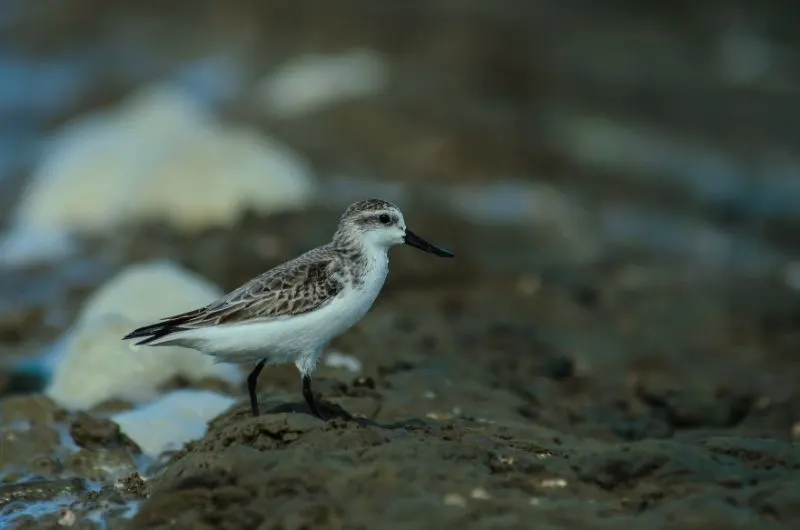Spoon-Billed Sandpipers get their name from their distinctive bill which is shaped like a spoon and is used to feed by sifting through shallow water for small crustaceans and mollusks.
- Status: Critically endangered
- Known as: Spoon-Billed Sandpiper.
- Estimated numbers left in the wild: 360 to 600 (possibly less).
They are one of the rarest birds in the world, with only about 300 left in the wild.
The main threat they face is loss of habitat as wetlands dry up or become degraded due to development and climate change. This bird also faces threats from hunting, collisions with manmade objects such as power lines, fishing nets, and oil spills.

They have been protected under CITES since 1981 but none of these protections has proven effective in preventing their decline. In January 2019, the Spoon-Billed Sandpiper was finally listed as a critically endangered species on the IUCN Red List. This means that there is a high risk of extinction in the wild in the near future.
They are threatened with extinction because they only breed on four small islands in the Yellow Sea, making them incredibly vulnerable to natural disasters such as typhoons and flooding, as well as human interference such as pollution and hunting.
Description

Spoon-Billed Sandpipers are small birds, 14 to 16 centimeters long, with the usual sandpiper “look” – plump body, long black legs, and a rounded, alert-looking head.
Their feathers are ginger-colored on the head with darker brown streaks, while the back is darker. Their most distinctive feature is their beak. The tip is flared out into a “spatula” shape to be much wider at the end than at the base.
See Related: Amsterdam Albatross
Anatomy and Appearance
They are one of the rarest and most endangered birds on the planet. The bill of this bird is shaped like a spoon and is used to filter through shallow water for tiny crustaceans and mollusks.
Spoon-billed sandpiper plumage is brown with longitudinal white stripes on its wings, back, head, neck, breast, tail coverts, flanks, and underwing coverts.
They have dark eyes with horizontal palpebral slits giving them an owl-like appearance. They are small, slender wading birds that measure 9.8 inches in length and weigh 5 ounces on average. Their color ranges from light to dark brown with a pale gray bill tipped by black.
Location
The spoon-billed sandpiper nests in north-eastern Russia, mostly on the Kamchatka and Chukotsk peninsulas. It winters in Myanmar and Bangladesh.
A few individuals winter in Vietnam, India, China, Sri Lanka, Thailand, Singapore, and Malaysia. The summer range is tundra with freshwater pools, while the winter-favored habitat is mostly tidal flats.
See Related: Environmental Organization in Europe
Spoon-billed Sandpipers Habitat

They are found in Southeast Asia, primarily in China, Japan, and South Korea. They are also found in parts of Siberia, but their main habitat is the vast mudflats of the Yangtze and Yellow Rivers. Here Spoon-billed Sandpipers feed by sifting through the shallow water for small crustaceans and mollusks.
The Spoon-billed Sandpiper is a migratory bird and when main wintering grounds appear during the winter months, they can be found as far south as Australia and New Zealand.
Every year, however, a large number die during their migration. It is estimated that there are now only around 2,000 pairs of these bird species.
Spoon-billed Sandpipers Diet and Nutrition
These bird species are wading birds that feed on insects, small invertebrates, and a variety of larval and adult invertebrates such as worms.
They walk through the shallows, wet meadows, and similar areas, moving their red-brown head left and right to forage. Mudflats and saltpans are the areas favored by these birds in the winter, where invertebrate prey is plentiful.
See Related: Yellow-Eared Parrot
Spoon-billed Sandpipers Mating Habits

It is a bird species that are extremely territorial birds and almost breeding adults always return to precisely the same spot to breed each year.
These sites are defended vigorously by the males, who are the first to migrate north in the spring. These sandpipers are monogamous, with both parents tending the nest during the two to three weeks it takes the eggs to hatch. The species is very particular about the areas where it will nest, making it especially vulnerable to habitat destruction.
They will not nest further than 5 kilometers from the shore, prefer lagoon spits, and are typically the only nest where crowberry lichen, dwarf birch, and willow sedge are present, as well as freshwater pools.
The chicks follow their parents and forage alongside them for two weeks until they fledge and can join the southward migration at summer’s end.
Conservation Status
The Spoon-billed Sandpiper is classified as Critically Endangered on the IUCN Red List. Birdlife International and Wildlife conservation groups aim to lift the bird from the list.
Threats
Their single biggest threat is the bird trappers in Myanmar, where these waterfowl overwinter. Mist nets are often used to capture the birds alive to keep them fresh longer without refrigeration. Poisoned fish are also used to kill waterfowl for human consumption.
At least half of the Spoon-Billed Sandpipers winter in the Bay of Martaban, where the most intensive and successful subsistence hunting occurs.
Habitat loss in the birds’ summer range contributes to the species’ sharp and accelerating decline. Unfortunately, it appears that these unusual sandpipers may soon be extinct, perhaps as early as 2020.
Conservation efforts
Conservation efforts are underway to try to save the spoon-billed sandpiper, though these may be too little, too late. Some areas in the summer range are now protected, but it is urgently necessary for more to be done and for protection to be given and enforced in Myanmar.
One initiative supplies Myanmar bird trappers with the equipment needed for a different occupation since bird trapping is a highly undesirable way to make money. Most hunters would prefer to do something else.
See Related: Best Conservation Posters
Organizations
Wildfowl & Wetlands Trust

The Wildfowl & Wetlands Trust protects wetlands in the UK and around the world, and the wildlife found in these habitats like the Spoon-billed Sandpiper.
Final Thoughts
Spoon-billed Sandpipers are a rare species found in the wild. Spoon-bills get their name from their distinctive bill which is shaped like a spoon and is used to feed by sifting through shallow water for small crustaceans and mollusks. Habitat destruction has also been cited as being one of the major factors contributing to this bird’s endangerment status.
Spoonbill sandpiper conservation programs include supplying hunters with equipment that will allow them to find other work since trapping birds is not a desirable income generation for these people.
FAQ
Is the Spoon-Billed Sandpiper endangered?
Spoon-Billed Sandpipers (Eurynorhynchus pygmeus) are classified as vulnerable by the IUCN and it is believed that they’re decreasing in numbers. They feed on small crustaceans and mollusks with their long bill, which is shaped like a spoon.
The most important breeding season and sites for the bird species are in the Russian Far East, Coastal Southern China, Siberia, and locally in Japan where populations currently fluctuate between 2000 to 4000 individuals.
How many Spoon-Billed Sandpipers are left?
They are the most endangered wading bird in the world. Once numbering up to 10,000 pairs, Spoon-bills are now down to an estimated 500 pairs that live in Bangladesh’s northeast wetlands.
Other Species Profile
Related Resources
